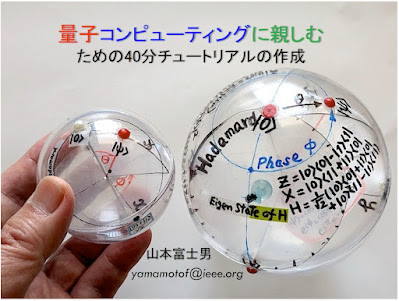The number of books on quantum computing has been steadily increasing. Here, I’d like to briefly introduce two books I recently purchased, both of which I found to be excellent.
🔴Peter Y. Lee, Huiwen Ji, Ran Cheng: Quantum Computing and Information, Polaris QCI Pub., 2nd edition, Feb. 2025
First off, I was excited to see the publication date listed as 2025—and the book certainly lives up to that excitement! With 502 pages, its thickness alone hints at the density of its content. The material ranges from beginner to intermediate levels and is presented with numerous illustrations, making it a great choice for those who want to study carefully and in depth.
 |
| Published in February 2025, 502 pages total, chapter titles provided by me |
 |
| Qiskit quantum app worked perfectly on my local environment |
🔴Jack D. Hidary: Quantum Computing - An Applied Approach, 2nd edition, Springer, Aug. 2021
This second book is also a thick, full-color hardcover with a total of 422 pages, targeting beginners to intermediate learners. The latter 170 pages provide a detailed introduction to the basics under the section titled Mathematical Tools for Quantum Computing, so it may be a good idea to review this part first.
The quantum algorithm section in the first half overlaps somewhat with the content of the aforementioned book by Lee et al., but I was happy to see that it includes QFT (Quantum Fourier Transform) and Shor’s Algorithm, which were not covered in that book. For instance, it walks through the entire process (quantum + classical parts) of factoring the small integer 15 (= 3×5), which greatly enhances reader's understanding of the Shor algorithm. Moreover, the second edition includes new content related to Quantum Machine Learning, which is a big plus.
(Note) Factoring a slightly larger integer like 184573 (= 487×379) is considered difficult in simulations due to memory limitations, and on current quantum computers due to limitations in qubit count and error rates. However, simulation is still possible by replacing "quantum order finding" with "classical order finding."
 |
| Published in August 2021, 422 pages total |
By the way, when you open this book, the Schrödinger equation appears right at the beginning—in other words, the wave function and the Hamiltonian. Since most books on quantum computing are computer science–oriented, this equation is rarely mentioned, which is a bit surprising. However, this is actually a very good thing, because both the quantum gate model and the quantum annealing method are said to originate from the time-dependent Schrödinger equation. Though the explanation spans only four pages, it clearly demonstrates, with a few equations, that “to understand the time evolution of a wave function, one must consider the total energy of the system.” Specifically, it derives the case of a harmonic oscillator potential, as shown below.
 |
| Schrödinger Equation – Harmonic Oscillator Potential |
Also, please note that the quantum algorithm programs provided in the book are written in Google’s Cirq, not IBM’s Qiskit as mentioned earlier. These programs were created in an older Cirq environment than mine, and I encountered various errors when trying to run them. However, the official Google Cirq site provides examples very similar to those in the book, and I was able to run them perfectly in my Cirq setup! Using those as a reference, you should be able to run the remaining examples in the book as needed.
 |
| Examples from Google Cirq |
🔴Note the differences between IBM and Google machines
Lastly, there's something important to keep in mind: the bit order in quantum registers is reversed in IBM Qiskit (Little Endian) and Google Cirq (Big Endian)! This is an easy mistake to make and can cause all sorts of confusion. For example, if the initial state of three qubits is |000⟩, applying X gates to q1 and q2 results in q0q1q2 → 011 in Cirq, but q2q1q0 → 110 in Qiskit. For more details, please refer to my earlier article, Testing My Mobile Quantum Circuit Simulator.
tinyurl------- https://tinyurl.com/eaacxan2 -------



